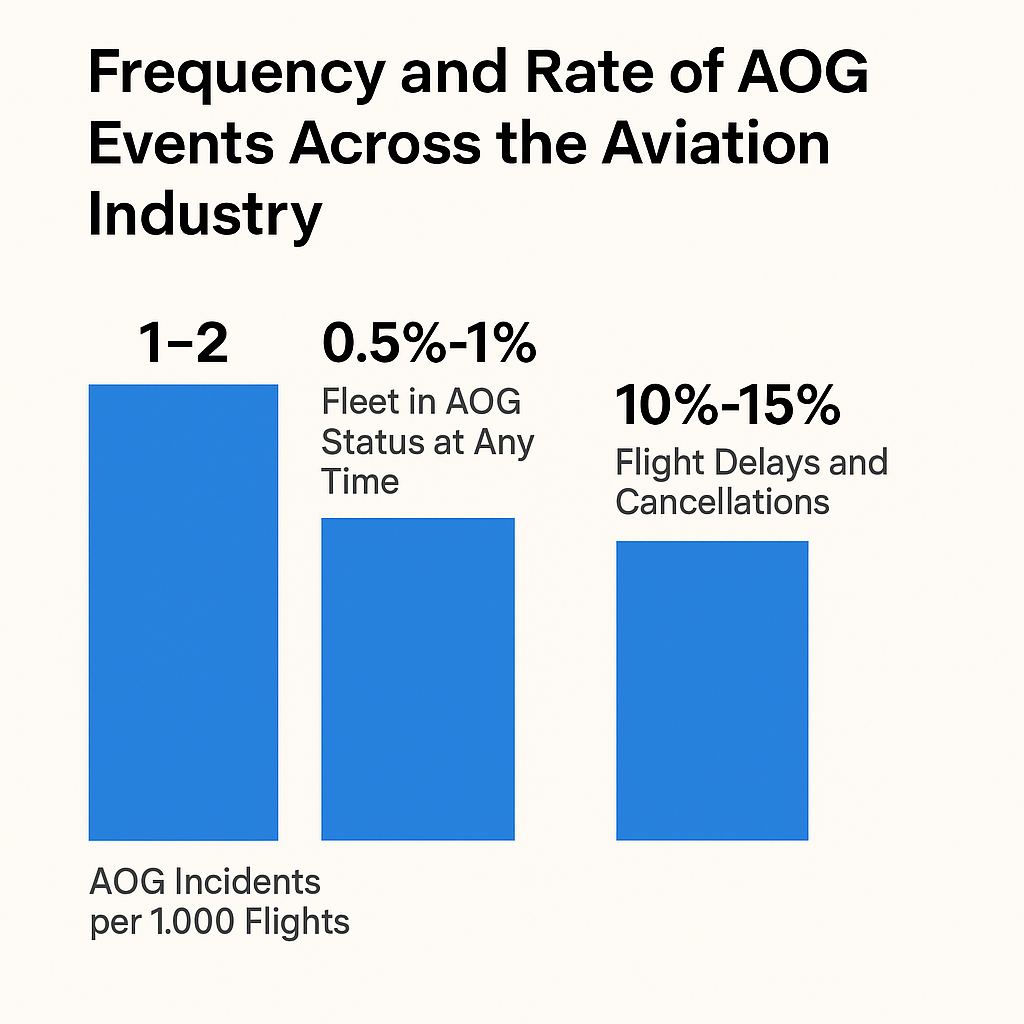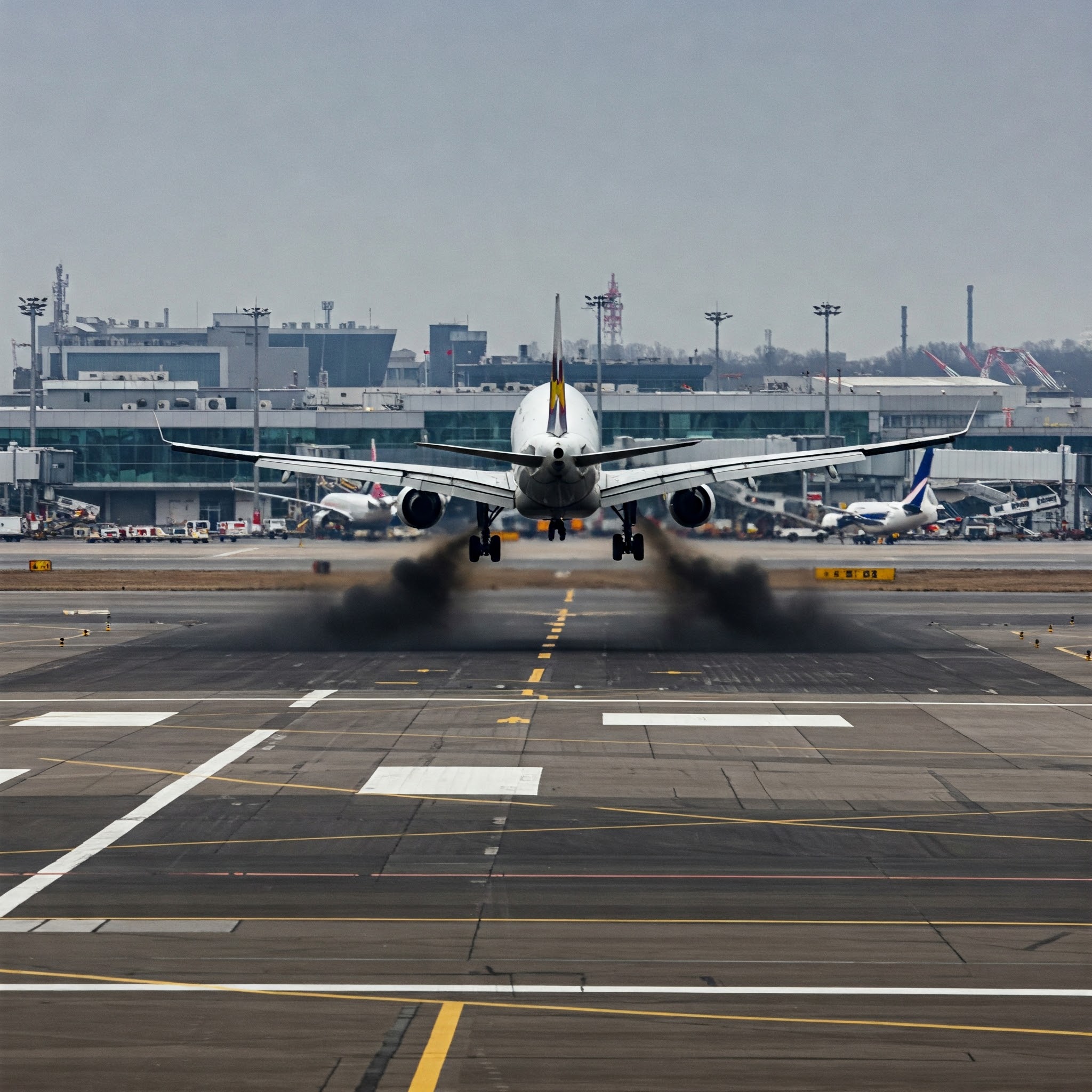In aviation delays could lead to operational challenges and increased costs. An 'Aircraft on Ground' (AOG) situation refers to any condition where an aircraft is unable to fly due to technical malfunctions, maintenance needs or unavailability of necessary spare parts. During such events, the aircraft is considered out of service, resulting in potential delays, missed schedules, and dissatisfied customers.
Efficiently handling AOG events is essential for minimizing disruptions and ensuring fleet readiness. Despite rigorous maintenance schedules and proactive safety checks, unexpected issues can still arise, halting operations and demanding immediate intervention.

This image was created with Gemini 2.0 Flash support.
Causes of Aircraft on Ground (AOG) Status
Several factors may contribute to an aircraft being designated as AOG. These causes range from mechanical failures to external environmental factors, each requiring distinct response protocols:
- Mechanical Issues: Faulty components, system malfunctions, or structural problems can render an aircraft unfit for flight. These technical issues must be promptly diagnosed and addressed to return the aircraft to service.
- Lack of Spare Parts: Sometimes, the necessary replacement part is not readily available due to supply chain or logistical challenges. Whether it's a part stored at a different facility or on backorder, the wait time can significantly prolong the aircraft's downtime.
- Maintenance Checks: Routine and non-routine maintenance procedures are crucial for aircraft safety and airworthiness. However, these inspections may uncover additional problems, which may take more time to repair than initially expected.
- Weather Conditions: Severe weather events such as hurricanes, snowstorms or lightning can make it unsafe for aircraft to operate, leading to unplanned groundings.
- Unforeseen Circumstances: Events like bird strikes, fuel leaks, or foreign object damage may instantly put an aircraft out of commission. These incidents require immediate attention and investigation before the aircraft can be declared airworthy again.
Frequency and Rate of AOG Events Across the Aviation Industry
In the aviation industry, AOG events are an inevitable reality. Although strict maintenance programs and technological advancements have significantly reduced malfunctions, AOG incidents cannot be entirely eliminated.
Industry data suggests that major airlines experience approximately 1 to 2 AOG incidents per 1,000 flights. This rate can vary depending on the operational scale and the effectiveness of maintenance practices. Fleets with high aircraft utilization and long-haul operations tend to have a higher risk of AOG events.
Many operators plan for approximately 0.5% to 1% of their fleet to be in AOG status at any given time to ensure operational flexibility. Additionally, external factors such as severe weather or supply chain disruptions can temporarily increase these rates.
From a broader perspective, reports from organizations like the International Air Transport Association (IATA) indicate that AOG-related disruptions account for approximately 10–15% of total flight delays and cancellations. This highlights why efficient AOG management is critical not only for technical teams but also for overall airline operations.

This graphic was created with Gemini 2.0 Flash support.
Financial Cost
Beyond operational inconvenience, AOG situations can lead to various costs, including storage fees, emergency part shipments, maintenance labor and passenger compensation. These costs, along with lost revenue from grounded flights, contribute to the overall financial impact. A 2010 study by the Federal Aviation Administration (FAA) and NEXTOR estimated that airline delays in 2007 cost the U.S. airline industry approximately $31 billion, a portion of which was directly related to AOG-related disruptions.
Aircraft represent a significant investment, and when grounded, they generate no revenue. The longer an aircraft remains grounded, the higher the operational losses. In response, some operators/airlines have begun utilizing specialized insurance to mitigate the financial risks associated with AOG incidents.
Moreover, the ripple effects extend far beyond the operators/airlines themselves. Air cargo services, postal systems, and global logistics chains rely on the punctuality of flights. A delayed aircraft can cause late deliveries, upset consumers, and affect business reputations—impacting even those who rarely fly.

This image was created with Gemini 2.0 Flash support.
Operational Strategies
Operators/Airlines adopt a multi-step strategy to respond rapidly and effectively to AOG situations:
- Prompt Identification: The first priority is to diagnose the problem quickly. Maintenance personnel use diagnostic tools, technical manuals, and visual inspections to identify the root cause.
- Spare Parts Acquisition: Logistics teams work swiftly to procure the required spare parts. This may include sourcing from alternative suppliers or arranging for emergency shipping.
- Expedited Repairs: Once parts are in hand, technicians prioritize the repair process, often working around the clock to restore the aircraft to airworthy condition.
- Collaboration with OEMs: Original Equipment Manufacturers (OEMs) provide valuable technical support, especially for complex repairs or rare component issues. Their involvement can significantly accelerate recovery time.
- Crisis Management: Effective communication and contingency planning are essential. Operators/Airlines must manage passenger expectations, offer alternate travel options, and maintain transparency throughout the incident.
Handling AOG scenarios successfully depends on the efficiency of maintenance teams, the resilience of supply chains, and the overall coordination between departments. Operators/Airlines continuously refine these systems to reduce downtime and maintain customer satisfaction.

This image was created with Gemini 2.0 Flash support.
"Aircraft on Ground" (AOG) is a critical operational status in aviation, indicating that an aircraft is temporarily out of service. Whether due to mechanical faults, environmental conditions, or logistical delays, AOG events present both financial and operational challenges. Operators/Airlines must act swiftly and strategically to resolve such incidents, employing methods such as rapid diagnostics, spare parts management, and OEM collaboration. By minimizing the impact of AOG, operators/airlines protect their revenue streams, maintain flight schedules, and uphold trust with both passengers and commercial partners.


